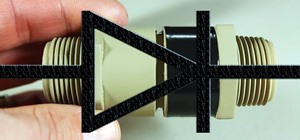Open-source Mars roverSeth King wasn’t satisfied with current robotics platforms that don’t work well outdoors. He started the with the end goal of having a 6-wheel robot with a rocker-bogie suspension just like the Mars landers.
We’re sure it’ll be an interesting platform. Adding a Flash to a key fob video cameradoctormord picked up a key fob “spycam” and was surprised that there wasn’t any onboard illumination. Then again, that would probably defeat the purpose of the “spycam.” , he had a camera with a light.
Automated WEP crackingof Elliott using his to crack a WEP wi-fi network. It took Elliott less than a minute to crack a network he set up.

Lesson: don’t use WEP. Adding wi-fi to a laptop the fast wayThis laptop used to have a broken Mini-PCIe wi-fi adapter. Mikko fixed the wireless by taking out the old card and hooking up a USB wi-fi adapter. He soldered the USB leads directly to the back of an internal USB port and used hot glue “to prevent bad things from happening.” A very easy, fast, and cheap way of fixing a broken wireless adapter. Han Solo’s soldering ironWhen Craig was 15, he broke the Bakelite casing of his father’s soldering iron.
Being a good son,. Nice, but not as great as. Posted in Tagged,.
Long rant incoming. I am assuming you are asking about FPGA based prototyping of physical layer algorithms. This was my final year in undergraduate + entire grad school + thesis (+ some of my spare time as of now). The learning curve depends on whether you have an electronics-comms+signal processing subject background, or that of an electronics-embedded engineer.
If you are from an embedded side (judging from the way the question was asked), there will be maths, and it might be a tad annoying. There is more signal-processing maths than the embedded part.
Actually, its mapping the math to the embedded part. First, the inspiring part: this is how quite a few physical layer algorithms end up becoming ASIC's in the first place. Crudely put, design is simulated in a Signal Processing Workbench/ MATLAB-like environment and an RTL or VHDL implementation is then created (there are tools which automate the implementation part these days, though hand crafting might still be neccessary). This design is then fed alongwith other similar components to an FPGA manufacturers (say Xilinx) board design tools (in this case, Xilinx Embedded Development Kit). The parts/IP are combined with a custom CPU core (can be designed in Xilinx ISE or you can even use an ARM core these days), finally the design is synthesized on an FPGA.
Ofc, the RF portion is separately connected to the FPGA IO. 'Somewhat similar' routine is followed with the RTL designs too before they become actual ASIC's.

In most cases, an FPGA prototypes are an intermediate step to a customized ASIC design. Those chips might end up being relatively simpler IC's used in wireless routers, sensors etc, to something as mammoth as an application processor (running its own operating system) integrated with a front end. The basic design principle is the same. A simple analogy might be where you start with an MCU dev kit to work out your design kinks, then take your final program, flash the hex on to your mcu, and finally solder it on to your custom PCB. Except this is just a bit more complicated.
Des Cracker Online
This is not a hobby, nor will a hobbyist's budget suffice for the equipment. Even simple DAQ kits like USRP (for the gnuradio) cost over 800USD with an RF front end for high frequencies.
Low frequency kits(which make a mockery of the word SDR, and look like plugin sticks btw) are easily available from most vendors. Altera recently came out with its own bemarco/whatever. If you just want to learn, an easier way is to simply check out the GNUradio project and use signal data sets posted online for processing in your PC (the free option without the fpga, but with the actual signals being processed in your PC, and in Python/C).
Or maybe use Matlab with Xilinx System Generator/Altera DSP Builder/Synphony High Level Synthesis (the not so free option, but with VHDL involved). To get started, you will need an FPGA starter kit, and an RF front end. RF side merely needs an upconverter, filter and an antenna.
Maxim and Analog Devices sell some kits for those. If you are in an university, try to find out if they have kits like WARP etc. You only need one kit as a transceiver, the other side can simply be a signal generator or a spectrum analyzer(vector preferred). Running out of time, might post some more detail later on the weekend. In the meantime, check out Sora, WARP, GNUradio, Nutaq, etc. Google for others; there are plenty, none are cheap.

Joseph Zambreno
Also Google fpga bpsk designs/fpga bpsk sdr. Don't bother with the 802.11 series protocols, before you can even simulate a bpsk mod/demod with its own AGC on the FPGA.
Posts
- Farming Simulator 15 Pc
- Make The Goth Girl Laugh
- Hp Chemstation Software
- Evaluating And Selecting Efl Teaching Materials Pdf File
- Toon Disney Fillmore Mystery Game
- How To Exit Mode Lg G2
- Download Spiderman Mod For Gta 3
- The Rheology Handbook Mezger Pdf
- How To Save Pl Sql Program In Oracle 10g
- Asphalt 6 For Iphone 3g
- Elsawin Seat Data Dvd Vs Video
- Atmosphere Deluxe New Version Serial
- Gti Racing Cd Key Keygen
- Backlink Blaster
- Patch For Bitdefender
- Silent Hunter 3 Mods S
- Europolis Game
- Wbfs Games S
- Working Principle Of Elevator Pdf
- Download Software Yeti Sports Flamingo Drive Hacked
- Instructions Manual For Whirlpool Jacuzzi Bath
- Biologia De Robertis Pdf
- Idx Sub To Srt Converter
- Leapfrog Talking Words Factory
- Hp Photosmart M547 Driver